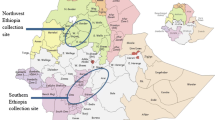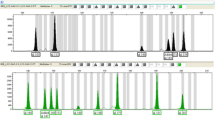Abstract
The potential of microsatellite markers for use in genetical studies in potato (Solanum tuberosum) was evaluated. Database searches revealed that microsatellite sequences were present in the non-coding regions of 24 potato genes. Twenty-two sets of primers were designed and products successfully amplified using 19 primer pairs. These were tested against a panel of 18 tetraploid potato cultivars. Four pairs of primers designed to amplify microsatellites from tomato were also used. Seven (including 2 of the tomato sequences) failed to reveal any variation in the accessions tested. Sixteen primer pairs did reveal polymorphism, detecting between 2 and 19 alleles at each locus. Of these, 3 gave rise to complex band patterns, suggesting that multiple polymorphic loci were being amplified using a single primer pair. Heterozygosity values ranged from 0.408 to 0.921. Phenetic analysis of the derived information allowed a dendrogram to be constructed depicting the relationships between the 18 potato cultivars. The potential of microsatellite markers for genetic analysis and satutory applications in potato is discussed in the context of these results. Furthermore, the potential of ‘crossspecies amplification’ is highlighted as an additional source of microsatellite markers for genetic research in potato.
Similar content being viewed by others
References
Akkaya MS, Bhagwat AA, Cregan PB (1992) Length polymorphisms of simple sequence repeat DNA in soybean. Genetics 132: 1131–1139
Beckmann JS, Soller M (1990) Toward a unified approach to genetic mapping of eukaryotes based on sequence tagged microsatellite sites. Biotechnology 8:930–932
Bell CJ, Ecker JR (1994) Assignment of 30 microsatellite loci to the linkage map of Arabidopsis. Genomics 19:137–144
Bishop MD, Kappes SM, Keele JW, Stone RT, Sunden SLF, Hawkins GA, Toldo SS, Fries R, Grosz MD, Yoo J, Beattie CW (1994) A genetic linkage map for cattle. Genetics 136:619–639
Bostein D, White RL, Skolnick M, Davis RW (1980) Construction of a genetic linkage map in man using restriction fragment length polymorphisms. Am J Hum Genet 32:314–331
Brunel D (1994) A microsatellite marker in Helianthus annuus L. Plant Mol Biol 24:397–400
Condit R, Hubbell SP (1991) Abundance and DNA sequence of two-base repeat regions in tropical tree genomes. Genome 34: 66–71
Dietrich W, Katz H, Lincoln SE, Shin H, Friedman J, Dracopoli NC, Lander ES (1992) A genetic map of the mouse suitable for typing intraspecific crosses. Genetics 131:423–447
Dirienzo A, Peterson AC, Garza JC, Valdes AM, Slatkin M, Freimer NB (1994) Mutational processes of simple sequence repeat loci in human populations. Proc Natl Acad Sci USA 91:3166–3170
Edwards K, Johnstone C, Thomson C (1991) A simple and rapid method for the preparation of plant genomic DNA for PCR analysis. Nucleic Acids Res 19:1349
Gebhardt C, Ritter E, Debener T, Schachtschabel U, Walkemeir B, Uhrig H, Salamini F (1989) RFLP analysis and linkage mapping in Solanum tuberosum. Theor Appl Genet 78:65–75
GENSTAT 5.0 Commitee (1987) GENSTAT 5.0 reference manual. Clarendon Press, Oxford
Hamada H, Petrino MG, Kakunaga T (1982) A novel repeated element with Z-DNA forming potential is widely found in evolutionarily diverse eukaryotic genomes. Proc Natl Acad Sci USA 79:6465–6469
Hearne CM, Ghosh S, Todd JA (1992) Microsatellites for linkage analysis of genetic traits. Trends Genet 8:288–294
Lagercrantz U, Ellegren H, Andersson L (1993) The abundance of various polymorphic microsatellite repeats differs between plants and vertebrates. Nucleic Acids Res 21:1111–1115
Litt M, Luty JA (1989) A hepervariable microsatellite revealed by in vitro amplification of a dinucleotide repeat within the cardiac muscle actin gene. Am J Hum Genet 44:397–401
Morgante M, Olivieri AM (1993) PCR amplified microsatellites in plant genetics. Plant J 3:175–182
Nei M, Li WH (1979) Mathematical modelling for studying genetic variation in terms of restriction endonucleases. Proc Natl Acad Sci USA 74:5267–5273
Olson M, Hood L, Cantor C, Botstein D (1989) A common language for physical mapping of the human genome. Science 245:1434–1435
Powell W, Phillips MS, McNicol JW, Waugh R (1991) The use of DNA markers to estimate the extent and nature of genetic variability in Solanum tuberosum cultivars. Ann Appl Biol 118:423–432
Powell W, Baird E, Duncan N, Waugh R (1993) Chloroplast DNA variability in old and recently introduced potato cultivars. Ann Appl Biol 123:403–410
Powell W, Morgante M, Vogel J, Tingey S, Rafalski AJ (1994) technology for plant genome analysis and breeding. In: Proc IPBA. Rogia, Slovenia, pp 177–180
Rafalski JA, Tingey SV (1993) Genetic diagnostics in plant breeding: RAPDs, microsatellites and machines. Trends Genet 9:275–280
Rohrer GA, Leeson AJ, Keele JW, Smith TP, Beattie CW (1994) A microsatellite linkage map of the porcine genome. Genetics 136: 231–245
Saghai-Maroof MA, Soliman KM, Jorgensen RA, Allard RW (1984) Ribosomal DNA spacer length polymorphism in barley: Mendelian inheritance, chromosomal location and population dynamics. Proc Natl Acad Sci USA 81:8014–8018
Saghai-Maroof MA, Biyashev RM, Yang GP, Zhang Q, Allard RW (1994) Extraordinarily polymorphic microsatellite DNA in barley: species diversity, chromosomal locations and population dynamics. Proc Natl Acad Sci USA 91:5466–5470
Senior ML, Heun M (1993) Mapping maize microsatellites and polymerase chain reaction confirmation of the repeats using a CT primer. Genome 36:884–889
Sarikawa T, Kuramoto, T, Hilbert P, Mori M, Yamada J, Dubay CJ, Lindpainter K, Ganten D, Gunet J-L, Lathrop GM, Beckmann JS (1992) Rat gene mapping using PCR-analysed microsatellites. Genetics 131:701–721
Soller M, Beckmann JS (1983) Genetic polymorphism in varietal identification and genetic improvement. Theor Appl Genet 67:25–33
Tautz D (1989) Hypervariability of sample sequences as a general source for polymorphic DNA markers. Nucleic Acids Res 17: 6463–6471
Tautz D, Rentz M (1984) Simple sequences are ubiquitous repetitive components of eukaryotic genomes. Nucleic Acids Res 12: 4127–4138
Thomas MR, Scott NS (1993) Microsatellite repeats in grapevine reveal DNA polymorphisms when analysed as sequence-tagged sites (STS). Theor Appl Genet 86:985–990
Thomas MR, Cain P, Scott NS (1994) DNA typing of grapevines: a universal methodology and database for describing cultivars and evaluating genetic relatedness. Plant Mol Biol 25:939–949
Wang Z, Weber JL, Zhong G, Tanksley SD (1994) Survey of plant short tandem DNA repeats. Theor Appl Genet 88:1–6
Welsh J, McClelland M (1990) Fingerprinting genomes using PCR with arbitrary primers. Nucleic Acids Res 18:7213–7218
Wiessenbach J, Gyapay G, Dib C, Vignal A, Morissette J, Millasseau P, Vaysseix G, Lathrop M (1992) A second generation map of the human genome. Nature 359:794–801
Williams JGK, Kubelik AR, Livak KJ, Rafalski JA, Tingey SV (1990) DNA polymorphisms amplified by arbitrary primers are useful as genetic markers. Nucleic Acids Res 18:6531–6535
Wu K-S, Tanksley SD (1993) Abundance, polymorphism and genetic mapping of microsatellites in rice. Mol Gen Genet 241: 225–235
Zhao X, Kochert G (1993) Phylogenetic distribution and genetic mapping of a (GGC)n microsatellite from rice (Oryza sativa L.). Plant Mol Biol 21:607–614
Author information
Authors and Affiliations
Additional information
Communicated by J. W. Snape
Rights and permissions
About this article
Cite this article
Provan, J., Powell, W. & Waugh, R. Microsatellite analysis of relationships within cultivated potato (Solanum tuberosum). Theoret. Appl. Genetics 92, 1078–1084 (1996). https://doi.org/10.1007/BF00224052
Received:
Accepted:
Issue Date:
DOI: https://doi.org/10.1007/BF00224052




